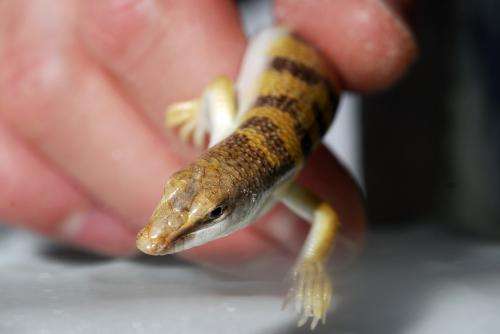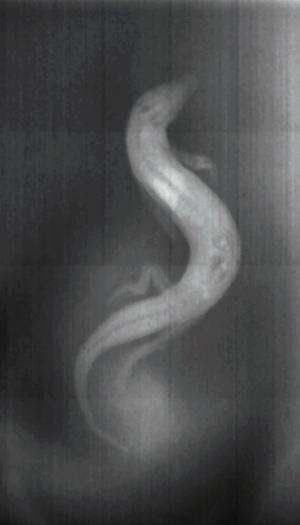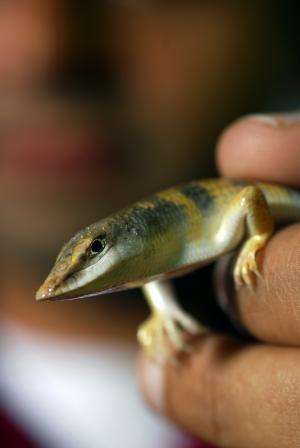New model finds common muscle control patterns governing the motion of swimming animals

What do swimmers like trout, eels and sandfish lizards have in common? According to a new study, the similar timing patterns that these animals use to contract their muscles and produce undulatory swimming motions can be explained using a simple model. Scientists have now applied the new model to understand the connection between the electrical signals and body movement in the sandfish.
Most swimming creatures rely on an undulating pattern of body movement to propel themselves through fluids. Though differences in body flexibility may lead to different swimming styles, scientists have found "neuromechanical phase lags" in nearly all swimmers. These lags are characterized by a wave of muscle activation that travels faster down the body than the wave of body curvature.
A study of the sandfish lizard – which "swims" through sand – led to development of the new model, which researchers believe could also be used to study other swimming animals. Beyond assisting the study of locomotion in a wide range of animals, the findings could also help researchers design efficient swimming robots.
"A graduate student in our group, Yang Ding, who is now at the University of Southern California, was able to develop a theory that could explain the kinematics of how this animal swims as well as the timing of the nervous system control signals," said Daniel Goldman, an associate professor in the School of Physics at the Georgia Institute of Technology. "For animals swimming in fluids using an undulating movement, there are basic physical constraints on how they must activate their muscles. We think we have uncovered an important mechanism that governs this kind of swimming."
The research was reported June 3 in the early edition of the journal Proceedings of the National Academy of Sciences. It was sponsored by the National Science Foundation's Physics of Living Systems program, the Micro Autonomous Systems and Technology (MAST) program of the Army Research Office, and the Burroughs Wellcome Fund.

Undulatory locomotion is a gait in which thrust is produced in the opposite direction from a traveling wave of body bending. Because it is so commonly used by animals, this mode of locomotion has been widely used for studying the neuromechanical principles of movement.
Sarah Sharpe, the paper's second author and a graduate student in Georgia Tech's Interdisciplinary Bioengineering Program, led laboratory experiments studying undulatory swimming in sandfish lizards. She used X-ray imaging to visualize how the animals swam through sand that was composed of tiny glass spheres.
At the same time their swimming movements were being tracked, a set of four hair-thin electrodes implanted in the lizards' bodies were providing information on when their muscles were activated. The two information sources allowed the researchers to compare the electrical muscle activity to the lizards' body motion.
"The lizards propagate a wave of muscle activations, contracting the muscles close to their heads first, then the muscles at the midpoint of their body, then their tail," said Sharpe. "They send a wave of muscle of contraction down their bodies, which creates a wave of curvature that allows them to swim. This wave of activation travels faster than the wave of curvature down the body, resulting in different timing relationships, known as phase differences, between muscle contracts and bending along the body."
Sand acts like a frictional fluid as the sandfish swims through it. However, a sandfish swimming through sand is simpler to model than a fish swimming through water because the sand lacks the vortices and other complex behavior of water – and the friction of the sand eliminates inertia.

"Theoretically, it is difficult to calculate all of the forces acting on a fish or an eel swimming in a real fluid," said Goldman. "But for a sandfish, you can calculate pretty much everything."
The relative simplicity of the system allowed the research team – which also included Georgia Tech professor Kurt Wiesenfeld – to develop a simple model showing how the muscle activation relates to motion. The model showed that combining synchronized torques from distant points in the lizards' bodies with local traveling torques is what creates the neuromechanical phase lag.
"This is one of the simplest, if not the simplest, models of swimming that reproduces the neuromechanical phase lag phenomenon," Sharpe said. "All we really had to pay attention to was the external forces acting on an animal's body. We realized that this timing relationship would emerge for any undulatory animal with distributed forces along its body. Understanding this concept can be used as the foundation to begin understanding timing patterns in all other swimmers."
The sandfish swims using a simple single-period sinusoidal wave with constant amplitude. A key finding that facilitated the model's development was that the sandfish's body is extremely flexible, allowing internal forces – body stiffness – to be ignored.
"This animal turns out to be like a little limp noodle," said Goldman. "Having that result in the theory makes everything else pop out."
The model shows that the waveform used by the sandfish should allow it to swim the farthest with the least expenditure of energy. Swimming robots adopting the same waveform should therefore be able to maximize their range.
Goldman and his colleagues have been studying the sandfish, a native of the northern African desert, for more than six years.
"Sandfish are among the champions of all sand diggers, swimmers and burrowers," said Goldman. "This lizard has provided us with an interesting entry point into swimming because its environment is surprisingly simple and behavior is simple. It turns out that this little sand-dweller may be able to tell us things about swimming more generally."
More information: Yang Ding, Sarah Sharpe, Kurt Wiesenfeld and Daniel Goldman, "Emergence of the advancing neuromechanical phase in resistive force dominated medium," Proceedings of the National Academy of Sciences, 2013.
Journal information: Proceedings of the National Academy of Sciences
Provided by Georgia Institute of Technology


















